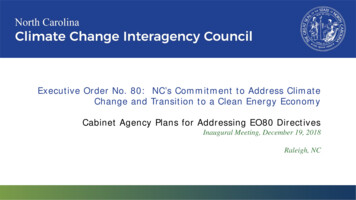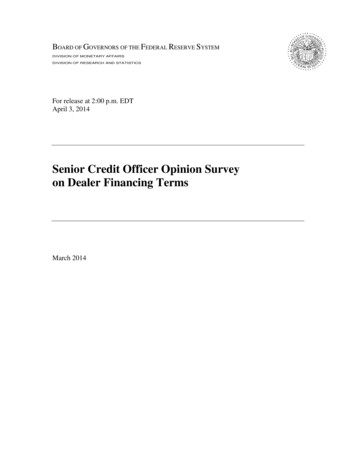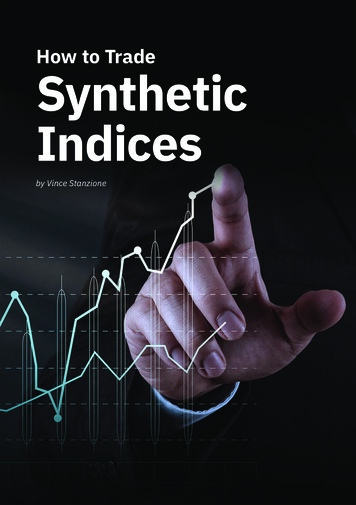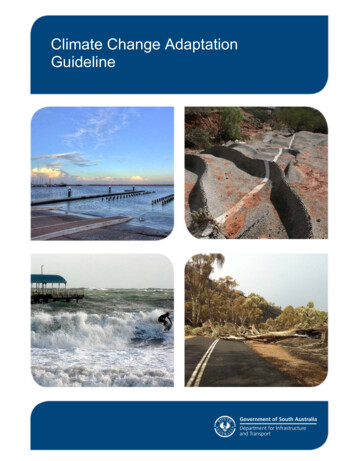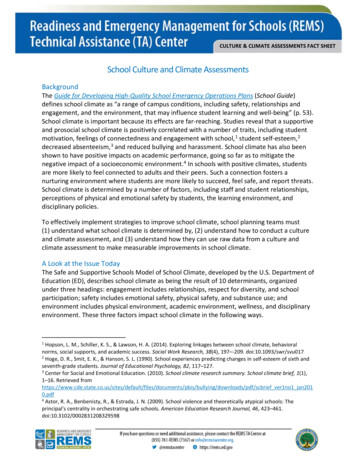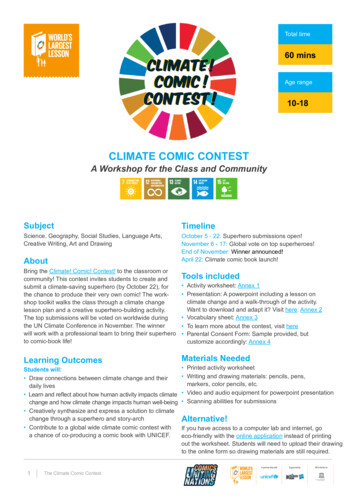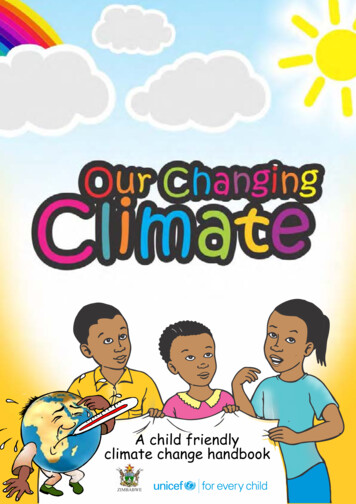
Transcription
Synthetic Solutions to the Climate CrisisSynthetic Solutionsto the Climate Crisis:The Dangers of SyntheticBiology for Biofuels ProductionSeptember 2010www.foe.org1
Synthetic Solutions to the Climate CrisisExecutive SummaryBiotechnology is portrayed as a panacea for climate changeand other societal ills. However the claims that geneticallyengineered plants and microbes can sequester more carbon inthe soil and produce more fuels when processed than conventionalmethods have yet to be proven. In the wake of these unfulfilledpromises emerges a more extreme form of genetic engineering, alsotouted as the solution to the climate crisis – synthetic biology.Genetic engineering involves inserting genes from one speciesinto another but the goal of synthetic biology is to create life formsfrom scratch using synthetic, computer-generated DNA or in somecases without the use of DNA entirely.Synthetic biology is not a sustainable solution to the climatecrisis and has the potential to create an entirely new set of problems.Genetic contamination – where the genetic makeup of a man-madeorganism effectively roots out or destroys an indigenous species inthe natural environment – is a serious threat to biodiversity, the environment, and public health. This happened when genetically engineered crops like corn were introduced in the U.S. in the early 1990sand contaminated entire strains. Synthetic biology exacerbates thisproblem since no one knows how organisms with synthetic DNAwill act in the open environment. They could die immediately – orthey could find a niche and devastate ecosystems as other invasivespecies have done.In spite of this threat, commercial applications for producingbiofuels through synthetic biology are under way. Brand new formsof algae, yeast, and other organisms are being designed with synthetic DNA to produce fuels or to more efficiently break down existing land-based crops to be fermented into fuels.This research is backed primarily by the oil industry. Additionally, the federal government provides these corporations withhundreds of millions in taxpayer money to research and patentorganisms for fuel and then sell that fuel back to the public. Oilcompanies have already destroyed the environment and should notbe rewarded for putting profits ahead of protecting human healthand the environment.The only way to safeguard against possible environmental disaster is to place an immediate moratorium on the release and commercial use of all synthetic organisms into the environment and conductfull environmental and social impact statements on all syntheticbiology research. Dangerous and unproven synthetic biology projects have diverted investments away from safe and clean technologies like wind and solar, and energy efficiency. A moratorium wouldrevive research and development of these renewable energy sources,end dependence on fossil fuels and safeguard the environment andall those that depend on it.2 Friends of the Earth
Synthetic Solutions to the Climate CrisisIntroductionScientists have been manipulating the genetic code since theearly 1970s when they began genetically engineering bacteria,plants, and animals.1 Over the years genes have been insertedinto crops to make them resistant to certain herbicides or to producetoxins in their cells that kill insects;2 fish and rabbits are injectedwith genes from jellyfish and coral to make them glow for purelyaesthetic purposes.3Since then, biotechnology has been portrayed as a panacea forclimate change and other societal ills. The Biotechnology IndustryOrganization (BIO), the industry’s largest trade group, declares thatthese technologies are fueling,4 feeding5 and healing the world.6Monsanto, a biotech giant, claims that its genetically engineeredseeds will produce drought resistant crops and sequester carbon.7The industry also says that that genetically engineered plants produce more ethanol,8 or other fuels,9 when processed. By injectingDNA from one organism with a desired trait—say drought resistance—into another plant, scientists can tweak naturally existingplants, yeasts, algae, and bacteria to make “better”10 ones. But “better” more often refers to the profits they can bring in once patentedrather than the benefits to people or the planet. Already a handful ofcorporations have benefited from biotechnology at the expense ofthe environment, the climate, and public health.11The field of genetic modification is growing in complexity.Previously, genetic engineering involved taking a short segment ofDNA from one organism and inserting it into another organism toengineer a new, genetically modified creature. Scientists are nowable to manipulate genetic material like never before due to advances in genetic engineering, DNA sequencing, nanotechnology, androbotics. Combining these technologies, some scientists are attempting to create life from scratch or re-design existing life. The proponents of this more complex genetic engineering call it “syntheticbiology.” Its supporters claim that synthetic biology will be thesource of the new “green” and “renewable” fuel supply.12 The science behind synthetic biology and how it is used to produce biofuelswill be reviewed in Section 1.Section 2 will discuss the dangers synthetic biology poses to ourenvironment and public health, as well as risks to national security.Section 3 addresses the hype around synthetic biology and thefalse belief that fuels created through synthetic biology will savethe planet from climate change. Proponents of synthetic biology arebanking on the appeal of a ‘green’ techno-fix to win over the public,in spite of the very serious risks involved.13Section 4 critiques this false notion that biofuels producedthrough synthetic biology are a solution to the climate and energycrisis. It’s unlikely that synthetic organisms will be able to producethe amount of fuel and energy needed to become competitive withother sources of energy without seriously harming the environmentand public health, and perpetuating inequality around the world.GloFish has added a fluorescentprotein gene to zebrafish like this one.www.foe.org3
Synthetic Solutions to the Climate CrisisThe use of genetic engineering hasgrown at an incredible rate in agriculture production, the medical field, andmore recently to produce biofuels.Section 5 will show the oil industry and agribusiness’ connections to the synthetic biology field. With the support of oil giants,such as Exxon Mobile and BP, synthetic biology startup companieshave started producing fourth generation biofuels from man-madeorganisms. The patenting procedure for synthetic life forms and howcompanies can manipulate the system to control the fuel supply willthen be discussed.Amyris Biotechnologies is one such company. It’s producingbiofuels and medicines with synthetic yeast, and is a prime exampleof how synthetic biologists use their connections with Big Oil andthe government to promote unproven and unregulated products. Theharms caused by Amyris’ biofuels production efforts in Brazil willbe highlighted in Section 6.Next, Section 7 will highlight the other major funder of synthetic biology research – the U.S. government. With the help of federal contracts, grants, and friends in high places, synthetic biologycompanies have been able to receive significant amounts of publicfunding to start their operations and patent their organisms. Thesecompanies are also being supported by U.S. biofuels policies thatare promoting new and alternative sources of biofuels.Section 8 reveals how synthetic biologists hope to thwart anyattempts at oversight and lays out the argument for precaution.The report concludes with policy recommendations to regulatesynthetic biology in Section 9 and why such regulations are necessary to protect the environment and public health from the uniquedangers posed by synthetic organisms.1. The Science of Synthetic BiologyA Brief History of Genetics:To better understand the new dangers posed by synthetic biology, it is important to briefly cover major advances in genetics andour understanding of how genes function. The father of genetics isGregor Mendel, a German monk, who in 1865 discovered that traitsare inheritable through experiments with pea plants. It wasn’t untilthe 1900s that the importance of this discovery was fully recognized. In the 1920s it was believed that genes constitute the basis oflife and evolution and those nucleic acids were a major componentof chromosomes. Alfred Hershey and Martha Chase proved in 1952that genes, in fact, were the carriers of genetic information.14In 1953 James Watson and Francis Crick made the historicdiscovery that DNA was formed by a double-strand helix of nucleotides.15 Until this time, scientists did not know how DNA wascomposed or constructed. This knowledge opened up the door tothe idea that we could re-construct DNA. Only twenty years afterthe structure of DNA was discovered, the first genetically engineered organism, a form of E. coli, was created in a process knownas genetic recombination. Recombinant DNA led to the birth of the4 Friends of the Earth
Synthetic Solutions to the Climate Crisisfirst genetic engineering company in 1977, Genentech, who startedmaking drugs with this new technology.16Since that time, the use of genetic engineering has grown at anincredible rate in agriculture production, the medical field, and morerecently to produce biofuels.Recombinant DNA, better known as genetic engineering, haspreviously relied on taking genes from one organism and insertingit into a new organism. The combinations of genes were limited toDNA that could be found in nature. The discovery of DNA synthesis has changed that and now DNA and genes can be created fromscratch without needing to find them in nature. This emerging fieldis known broadly as synthetic biology.Defining Synthetic Biology:Synthetic biology is “the design and construction of new biological parts, devices and systems that do not exist in the natural worldand also the redesign of existing biological systems to performspecific tasks.”17Instead of inserting genes from one species into another, what isconsidered genetic engineering, synthetic biology aims to create lifefrom scratch with synthetic DNA or without the use of DNA entirely. DNA is synthesized on a computer and “printed” out, which canthen be shipped anywhere in the world through the mail. While therange of practices referred to as “synthetic biology” varies, they allinvolve taking genetic engineering to a new extreme.18Approaches to Synthetic Biology:There are several approaches to creating synthetic life forms currently being used, each of which is working on a different scale. Atthe most basic level is the production of synthetic DNA through thearrangement of nucleotide bases: adenine, thymine, cytosine, andguanine—represented by the letters A, T, C, and G. Once a DNAsequence has been uploaded or typed into a computer, it can be“printed” out onto a sheet of glass from bottles of A, T, C, and G.The first synthetic gene was created in 1970 with 207 nucleotides.19 DNA synthesis has evolved greatly since the 1970s andcan now be done relatively cheaply and quickly by gene synthesiscompanies that are popping up across the globe. Customized DNAstrands can be purchased online and delivered through the mail forjust 0.40 a base pair—compared to 10- 20 per base pair just tenyears ago.20 These base pairs can then be arranged into genes that,through RNA (ribonucleic acid), code for desired proteins. 1Proteins are built out of the twenty known amino acids. Codons,a serious of three chemical bases, determine which amino acid will1 To see a map of synthetic DNA companies, government laboratories, researchinstitutions, and universities conducting synthetic biology research andpolicy centers examining issues surrounding synthetic biology, please ries/map/www.foe.org5
Synthetic Solutions to the Climate CrisisDr. Clyde Hutchinson, Chair of thescientific advisory board of SyntheticGenomics, and Professor Emeritusof Microbiology and Immunology atthe University of North Carolina atChapel Hill.6 Friends of the Earthbe produced in a given cell. Much of the synthetic biology researchis occurring at the codon level, since it is through codons that scientists can chose among “biological instructions” for the desired traitexpression. Some synthetic biologists are even creating new artificial amino acids (outside the twenty found in nature) by combining codons in ways never done before21 or even trying to create lifewithout DNA entirely.22Drew Endy, formerly of Massachusetts Institute of Technologyand currently at Stanford University, founded the BioBricks Foundation. The Foundation is a registry of standard DNA sequences thatcode for certain functions.23 For example, DNA “parts” can be created that make an organism glow. One could request this “biobrick,”put it into an organism they want to engineer, and in theory theorganism should then be able to glow. These open-source “bricks”(often compared to toy “Lego” bricks) can be used by researchersacross the world to construct new genes and DNA sequences.Craig Venter of Synthetic Genomics and the J. Craig VenterInstitute created another approach. His research team produced anorganism with the minimum number of genes needed to survive.One could then add any DNA sequence to this “minimal genome”and produce fuel for cars, medicine, or any other synthetic product.In May 2010 Synthetic Genomics announced that it had madethe world’s first organism with a completely synthetic genome.“This was the first self-replicating species that we’ve had on theplanet whose parent is a computer,”24 according to Venter. The announcement was also the first time the majority of the public andpolicymakers had heard of synthetic biology or considered thefield’s risks and benefits.Another approach attempts to create life forms without DNA,like the field of “xenobiology,” which combines nucleic acids inways never done before in nature. Naturally, the four nucleic acids(A, T, C, and G), are linked together by the backbone of DNA – asugar group (2-deoxyribose) and phosphate. Xenobiologists hope tocombine the nucleotide bases to different sugars in the backbones,to create things such as threose nucleic acid (TNA), hexose nucleicacid (HNA), and glycol nucleic acid (GNA) – all of which neverexisted before in nature.25 The hope is that these organisms will notbe able to cross-breed with naturally occurring organisms, eliminating some risks of genetic engineering, but xenobiology carries itsown risks, such as invasive species with novel genetic constructs,that have yet to be assessed.Others hope to build life up from scratch by creating a “protocell.” To do this, researchers are combining inanimate chemicals andarranging them in such a way that they hope will eventually lead tothe creation of synthetic life. Some hope these protocells will provide insight into the origin of life and may lead to the creating ofnew organisms that don’t even need a DNA-like structure to surviveand multiply.26 This protcell approach is the closest in theory to creating “life from scratch” of all approaches to synthetic biology.
Synthetic Solutions to the Climate CrisisSynthetic Biology for Biofuels Production:Synthetic biology is being used in two different processes forbiofuels production: first is using synthetic enzymes to break downbiomass into sugars for fuel, and second is creating microbes thatproduce fuel directly.Enzymes, which are proteins that catalyze reactions, are beingengineered into microbes that can break down biomass much quicker than traditional methods. Synthetic DNA that codes for theseenzymes is inserted into microbes that then produce these syntheticenzymes. These enzymes can now be tailored towards specific typesof biomass, such as woodchips or corn stalks, and increase the rateat which they are broken down into sugars that can then be fermented into ethanol or other types of fuels. Examples of how syntheticenzymes are being used to break down biomass will be discussed insection 5 and even further in section 6 when Amyris Biotechnologies’ efforts to use yeast with synthetic enzymes to break downBrazilian sugarcane are discussed.The second approach being used to produce biofuels is throughcreating organisms, largely algae, that produce biofuels directly.Synthetic algae or other microbes do not necessarily require biomassto produce fuel, unlike organisms with synthetic enzymes, and instead can produce lipids that are processed into fuels from sunlight,water, and fertilizers. Synthetic biologists hope to change the organisms so that the oil they produce is chemically similar or identical tothe oils that are currently used in today’s transportation and energyinfrastructure.27 These microbes would become “living chemicalfactories” 28 that can be engineered to pump out almost any type offuel or industrial chemical.The Evolution of Understanding Genetics - A PrecautionaryTale:Scientists have learned an incredible amount about geneticssince Watson and Crick first discovered the DNA double-helix in1953. And while it’s now possible to construct synthetic DNA,engineering organisms out of synthetic DNA strands is uncharteredterritory.It was thought that with the Human Genome Project we wouldfind a one-to-one correlation between genes and traits. We nowknow this to be a grossly inaccurate belief. Some believed theywould find hundreds of thousands of genes, but in reality humanshave somewhere between 20,000-35,000 protein-coding genes,29which is not much more than that of a nematode or roundworm. Itwas even discovered in 2009 that corn plants have more than doublethe number of genes humans do.30Genes, sections of our DNA that actually code for proteins, onlymake up around 2 percent of our genome. Until recently, scientistsbelieved the other 98 percent was simply “junk DNA.” But scientists are learning that the “junk” is actually quite important andlikely regulates gene expression. Scientists are also learning thatwww.foe.org7
Synthetic Solutions to the Climate Crisis“If the societythat poweredthis technologycollapses insome way, wewould go extinctpretty quickly.”- Drew Endy, founder,International Genetically Engineered Machine (iGEM)inheritable changes in DNA can be caused by environmental andother factors, in the emerging field of epigenetics.31Understanding of genetics is evolving rapidly and has disprovedmany previously held beliefs and assumptions. What remains to beseen is how synthetic organisms will affect the environment andwhether scientific understanding of the role of DNA will precede itsapplication in industry. Precaution would lead us to further study thestill-unknown role genetics plays in the creation and development oforganisms before creating novel life forms with synthetic DNA.2. The Dangers of Synthetic BiologySynthetic biology alters the genetic material responsible forcreating every living thing on Earth. Challenging and attemptingto improve upon the original design of life ignores the evolutionary balance of the natural world. All life is interconnected, andthese new forms of man-made life will undoubtedly interact withthe Earth’s natural ecosystems. As the scientific field of ecologyhas shown, altering just one part of an ecosystem can affect all theliving beings within it. While ecosystems are always in flux, organisms tend to have a set place in the food chain with certain prey andpredators. Synthetic organisms may lack the predators that normallykeep populations in check.Drew Endy, a leader in the field of synthetic biology, recognizesthe danger this new technology poses. Scientists are now able tocreate synthetic organisms that produce biofuels and medicine andunfettered. Synthetic biologists claim that they might one day develop to methods to create new crop species and livestock, designerchildren and made-to-order pets.32 “We are talking about things thathave never been done before. If the society that powered this technology collapses in some way, we would go extinct pretty quickly.”Endy continues, “You wouldn’t have a chance to revert back to thefarm or the pre-farm. We would just be gone.”33 These are strongwords of warning from the same person who promotes “Do-it-Yourself” synthetic biology in people’s basements34 and helped createiGEM – the International Genetically Engineered Machine competition35 – which encourages undergraduate students to build novelbiological systems with “BioBricks.”2Environmental Risks:Whether a synthetic organism is released unintentionally from alab or intentionally into the environment, the threat to our ecosystemis the same. Since the widespread use of genetically engineered2 While not all work from the DIYbio and iGEM community falls under theumbrella of synthetic biology, much of the work is indeed syntheticbiology. iGEM encourages students to design their own BbioBricks,” orstandard DNA parts that can be synthesized and engineered into organismsanywhere around the world. DIYbio hopes to spread the tools of biologyand bioengineering to anyone who is interested, and much of this workdoes occur in people’s basements or garages.8 Friends of the Earth
Synthetic Solutions to the Climate Crisis(GE) crops, we have seen that GE plants have the ability toshare genes across species,36 evolve and mutate over time37, anddrastically affect entire ecosystems.38 GE crops generally use genesthat have been in the environment, but some of these new syntheticbiology creations are using DNA that are human-made and notfound in nature. While other types of pollution such as syntheticchemicals break down over time and do not breed, synthetic biological creations are designed to self-replicate and once released intothe environment they would be impossible to stop and could wipeout entire species. This type of pollution, known as genetic pollution, can be devastating since it cannot be cleaned up. Once it hasescaped, it can never be removed from the environment.Dr. Allison Snow, an ecologist at Ohio State University, explained at the Presidential Commission for the Study of Bioethical Issues meeting in 2010 what this scenario might actually looklike: “As a hypothetical example of a worst case scenario, a newlyengineered type of high-yielding blue-green algae (cyanobacteria)could be grown in thousands of acres of outdoor ponds for biofuels.Algae grown in open ponds will be engineered to be very hardy andthey could be more competitive than native strains. The new type ofengineered algae might spread to natural habitats—to lakes, rivers,and estuaries, where it might flourish and displace other species. Insome cases, this could result in algal blooms that suffocate fish andrelease toxic chemicals into the environment. So it would be a baddecision to go ahead with this kind of application.”39This leads to another major concern - the effect synthetic organisms will have on the ecosystem when they are created to surviveoutside the lab. Many hope synthetic organisms could be used tobreak down environmental pollutants such as oil spills.40 As a reportwritten by Michael Rodemeyer for the Wilson Center’s SyntheticBiology Project highlights, “synthetic organisms intended for noncontained use will be specifically engineered to survive and functionin the environment into which they are being released. As a result,they are more likely to be fit for survival and competition in thenatural environment than organisms intended solely for containeduse, making the risk of reproduction, spread, and evolution moreprobable.”41Experts in the field agree that there is no way to contain synthetic or genetically engineered organisms—particularly algae.According to Lissa Morganthaler-Jones, CEO and co-founder ofLivefuels Inc., a small number of genetically engineered algae havealready leaked from the lab into the environment. “They have beencarried out on skin, on hair and all sorts of other ways, like beingblown on a breeze out the air conditioning system,” she said.42 IsaacBerzin, founder of GreenFuel Technologies Corp., the first algae-tobiofuels company, believes that a leak hasn’t happened yet but thatit is inevitable. “Of course it’s going to leak, because people makemistakes,” said Berzin.43Synthetic biologists like to talk about designing in a “kill-A drawing from Aurora Algae showing the scale that open-air operationswill be working at within a year ortwo.www.foe.org9
Synthetic Solutions to the Climate CrisisThe fact that wecan’t predict thenovel risks createdby syntheticbiology is whywe need strongregulations fromthe beginning.10 Friends of the Earthswitch” or “suicide genes,” that could be used to stop any organismsfrom getting out of control if they are released into the environment.Craig Venter has described how his team of researchers “will be ableto engineer synthetic bacterial cells so they cannot live outside ofthe lab or other production environments. This is done, for example,by ensuring that these organisms have built in dependencies for certain nutrients without which they cannot survive. They can also beengineered with so called ‘suicide genes’ that kick in to prevent theorganism from living outside of the lab or the environment in whichthey were grown.”44 Other examples include algae designed withoutswimming flagella or an inability to absorb the low levels of carbondioxide found in seawater.45Unfortunately, ecology has shown that one cannot just engineersafety into synthetic organisms. Even if the novel organisms aredomesticated and seem innocuous, argues Dr. Snow, “mutationsor unexpected properties might allow them to multiply in someenvironments. Physical or biological confinement (which could bebased on engineered suicide genes or chemical dependencies) maynot work forever or in all cases because mutations, human error, orunexpected events might allow [genetically engineered organisms]GEOs to escape and reproduce.” Dr. Snow continues, “It would takeonly a few survivors to propagate and spread if biological confinement breaks down. The potential for rapid evolutionary change isespecially high in microbes. Some will die out but others may thriveand evolve. GEOs that can exchange genes with related lineages orother species could evolve even faster—allowing synthetic genes topersist in hybrid descendants. So, we cannot assume that all domesticated or supposedly ‘suicidal’ GEOs are unable to persist in theenvironment.”46 Issac Berzin agrees: “You know where you start but you don’t know where you are ending. Algae adapt to theirenvironment. Once you release it into the environment, guess what?They change. They get used to the worst toxins known to man We live on a small planet, so it doesn’t matter if disaster comes fromAfrica or China or New York. We are all going to be affected whenit happens.”47Once a synthetic organism enters the environment, eitherthrough intentional or unintentional release, the ways in which theseorganisms will interact with the natural environment is unpredictable, potentially devastating, and permanent. A synthetic organismdesigned for a specific task, such as eating up oil from oil spills inthe ocean, could interact with naturally occurring organisms andadversely harm the environment. The synthetic organism coulddisplace existing organisms or interfere with the existing ecosystem.Once it found an ecological niche in which to survive, it would bedifficult if not impossible to eradicate. 48The fact that we can’t predict the novel risks created by synthetic biology is why we need strong regulations from the beginning.According to a 2006 report from the New Atlantic, synthetic organisms “will lack a clear genetic pedigree and could have ‘emergentproperties’ arising from the complex interactions of its constituent
Synthetic Solutions to the Climate Crisisgenes Accordingly, the risks attending the accidental release ofsuch an organism from the laboratory would be extremely difficultto assess in advance, including the possible spread into new ecological niches and the evolution of novel and potentially harmfulcharacteristics.”49 It is the uncertainty of risk that must prompt us toestablish strong regulations from the beginning to ensure these fearsare not realized. As Dr. Snow has highlighted, what makes assessingrisk even more difficult is that most of the information from privateindustry is kept under lock and key as proprietary information.50Public Health and National Security Concerns:Beyond concerns that synthetic biology could wreak havocon Earth’s biodiversity, there is a real danger that the technologycould be used to make deadly viruses and other biological weapons. In 2002, researchers at the State University of New York atStonyBrook recreated the polio virus (which took generations toeradicate) from mail-ordered DNA sequences.51 In 2005, the U.S.Armed Forces Institute of Pathology recreated the 1918 SpanishInfluenza, which killed between 20-50 million people worldwide, to“help them better understand — and develop defenses against — thethreat of a future worldwide epidemic from bird flu.”52 What wouldhappen if these deadly viruses – which proved to work in a lab –were created with ill intention and released or unintentionally leakedfrom a lab?As a 2006 Washington Post article on bioterrorism highlighted,it is possible and completely legal for a person to produce the 1918influenza virus or the Ebola virus genomes. It is also legal forsomeone to provide kits, detailed procedures, and any other neededmaterials to reconstitute the full viral DNA genome, and they couldadvertise and sell these viruses as well.53 In fact, in June 2006 ajournalist for The Guardian had synthetic DNA fragments for theVariola major virus that causes smallpox sent to his house from acommercial gene synthesis company to show how easily it could bedone. As the ETC group highlights, the genome map of the Variolamajor is
Section 2 will discuss the dangers synthetic biology poses to our environment and public health, as well as risks to national security. Section 3 addresses the hype around synthetic biology and the false belief that fuels created through synthetic biology will save the planet from climate change. Proponents of synthetic biology are




